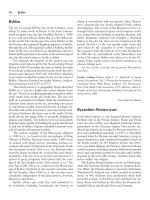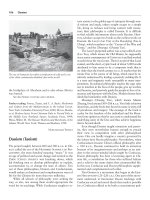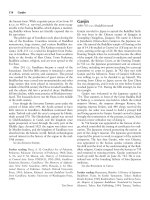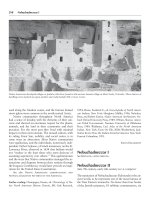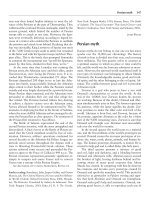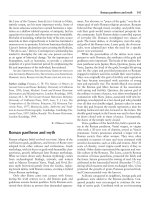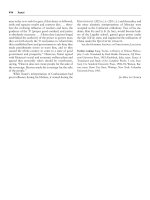Encyclopedia of world history (facts on file library of world history) 7 volume set ( PDFDrive ) 1974
Bạn đang xem bản rút gọn của tài liệu. Xem và tải ngay bản đầy đủ của tài liệu tại đây (164.22 KB, 1 trang )
Madison, James
253
rebel’s execution. Since Cartier’s death in 1873, Macdonald could no longer depend on a strong French
voice to maintain harmony between French and
English Canadians.
Shortly after a difficult 1891 reelection, Macdonald suffered a stroke and died a week later. Thousands attended his state funeral in Ottawa. His body
was taken by train to Kingston where Canada’s first
national leader was buried in a family plot in Cataraqui
Cemetery.
See also political parties in Canada; railroads in
North America.
Further Reading: Creighton, Donald G. John A. Macdonald.
Toronto: Macmillan, 1953; Smith, Cynthia M., and Jack
McLeod, ed. Sir John A.: An Anecdotal Life of John A. Macdonald. Toronto: Oxford University Press, 1989.
Marsha E. Ackermann
Madison, James
(1751–1836) statesman and American president
James Madison was born in Port Conway, Virginia,
to James Madison, Sr., and Eleanor Rose Conway.
They owned a prosperous tobacco plantation, run by
slaves, at the Montpelier estates in Orange County.
The eldest of 12 siblings, Madison was sickly as a
child, but excelled in school and entered the College
of New Jersey (now Princeton University) in 1769 and
graduated in 1771.
Madison returned to Virginia where he engaged in
local politics. He was too frail for military service himself during the American Revolution, but in 1774
was appointed to the Orange County, Virginia, Committee of Safety—a local wartime provisional government—and was heavily engaged in fundraising for the
county militia. In 1776 he was elected to the Virginia
Convention and worked on the state constitution. In
the same year Madison entered the Virginia House of
Delegates, where he met Thomas Jefferson.
From 1777 to 1780 he was a member of the Governor’s Council before being elected to the Continental Congress in 1779. There he became a spokesman
for stronger central government. Under the Articles of
Confederation each state remained sovereign, while
the weak central government could not even raise
enough revenue to pay the expenses generated by the
American Revolution. Another major deficiency of
the Articles of Confederation, in Madison’s eyes, was
James Madison was elected the fourth president of the United
States in 1808, beating Federalist candidate Charles Pinckney.
that it tied states, not individual citizens, to the federal government. Further, any amendment was impossible, since it required the unanimous consent of the
states.
In 1783 three years after the British surrender,
the Treaty of Paris was signed and Madison left the
Continental Congress. Back in Virginia, he studied
law and entered into real estate and served in the Virginia House of Delegates again, from 1784 to 1786,
where he drafted Virginia’s declaration on religious
freedom.
In 1786 Madison was Virginia’s delegate to the
Annapolis Convention on interstate trade, where he
decided to work for a revision of the U.S. Constitution and a stronger federal government, expressed in
his Virginia Plan. Again a member of the Continental
Congress from 1787 to 1788, he joined forces with
Alexander Hamilton and Jon Jay. Together they
wrote the Federalist Papers, published in newspapers

